A) the government
B) prices
C) subsidies
D) the Federal Reserve
F) B) and C)
Correct Answer

verified
Correct Answer
verified
Multiple Choice
Table 4-4
 -Refer to Table 4-4. Which supply schedules obey the law of supply?
-Refer to Table 4-4. Which supply schedules obey the law of supply?
A) Firm A's only
B) Firm B's, Firm C's, and Firm D's only
C) Firm A's and Firm C's only
D) Firm B's and Firm D's only
F) B) and C)
Correct Answer

verified
Correct Answer
verified
True/False
Suppose the demand for calendars increases in November. At the same time, the price of the ink used in the production of calendars increases. In the market for calendars, if the size of the shift of the demand curve is larger than the size of the shift of the supply curve, then the equilibrium quantity rises.
B) False
Correct Answer

verified
Correct Answer
verified
Multiple Choice
In a market economy, who or what determines who produces each good and how much is produced?
A) the government
B) lawyers
C) lotteries
D) prices
F) A) and B)
Correct Answer

verified
Correct Answer
verified
Multiple Choice
Figure 4-19
The diagram below pertains to the demand for turkey in the United States.
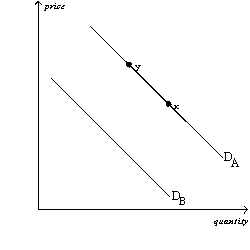 -Refer to Figure 4-19. All else equal, the premature deaths of thousands of turkeys would cause a move from
-Refer to Figure 4-19. All else equal, the premature deaths of thousands of turkeys would cause a move from
A) DA to DB.
B) DB to DA.
C) x to y.
D) y to x.
F) A) and C)
Correct Answer

verified
Correct Answer
verified
Multiple Choice
New cars are normal goods. What will happen to the equilibrium price of new cars if the price of gasoline rises, the price of steel falls, public transportation becomes cheaper and more comfortable, auto-workers accept lower wages, and automobile insurance becomes more expensive?
A) Price will rise.
B) Price will fall.
C) Price will stay exactly the same.
D) The price change will be ambiguous.
F) A) and B)
Correct Answer

verified
Correct Answer
verified
Multiple Choice
A downward-sloping demand curve illustrates
A) that demand decreases over time.
B) that prices fall over time.
C) the relationship between income and quantity demanded.
D) the law of demand.
F) B) and C)
Correct Answer

verified
Correct Answer
verified
Multiple Choice
In a competitive market, the price of a product
A) is determined by buyers, and the quantity of the product produced is determined by sellers.
B) is determined by sellers, and the quantity of the product produced is determined by buyers.
C) and the quantity of the product produced are both determined by sellers.
D) None of the above is correct.
F) C) and D)
Correct Answer

verified
Correct Answer
verified
True/False
An increase in supply will cause a decrease in price, which will cause an increase in demand.
B) False
Correct Answer

verified
Correct Answer
verified
Multiple Choice
Figure 4-16
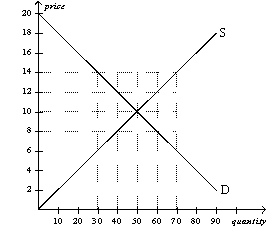 -Refer to Figure 4-16. If price in this market is currently $14, then there would be a(n)
-Refer to Figure 4-16. If price in this market is currently $14, then there would be a(n)
A) surplus of 20 units. The law of supply and demand predicts that the price will rise from $14 to a higher price.
B) excess supply of 20 units. The law of supply and demand predicts that the price will fall from $14 to a lower price.
C) surplus of 40 units. The law of supply and demand predicts that the price will rise from $14 to a higher price.
D) excess supply of 40 units. The law of supply and demand predicts that the price will fall from $14 to a lower price.
F) A) and C)
Correct Answer

verified
Correct Answer
verified
Multiple Choice
Figure 4-15
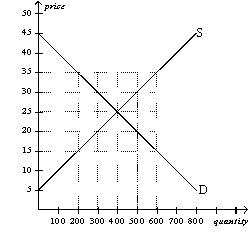 -Refer to Figure 4-15. At what price would there be an excess supply of 200 units of the good?
-Refer to Figure 4-15. At what price would there be an excess supply of 200 units of the good?
A) $15
B) $20
C) $30
D) $35
F) None of the above
Correct Answer

verified
Correct Answer
verified
Multiple Choice
The law of demand states that, other things equal, when the price of a good
A) falls, the demand for the good rises.
B) rises, the quantity demanded of the good rises.
C) rises, the demand for the good falls.
D) falls, the quantity demanded of the good rises.
F) A) and B)
Correct Answer

verified
Correct Answer
verified
Multiple Choice
The demand curve for textbooks shifts
A) only when income changes.
B) when a determinant of the demand for textbooks other than the price of textbooks changes.
C) when the price of textbooks changes.
D) Both b) and c) are correct.
F) A) and D)
Correct Answer

verified
Correct Answer
verified
Multiple Choice
Figure 4-20
The graph below pertains to the supply of paper to colleges and universities.
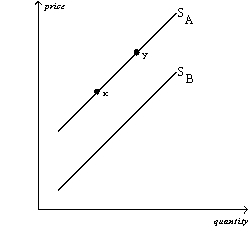 -Refer to Figure 4-20. All else equal, buyers expecting paper to be more expensive in the future would cause a current move from
-Refer to Figure 4-20. All else equal, buyers expecting paper to be more expensive in the future would cause a current move from
A) x to y.
B) y to x.
C) SA to SB.
D) SB to SA.
F) B) and C)
Correct Answer

verified
Correct Answer
verified
Multiple Choice
Figure 4-22
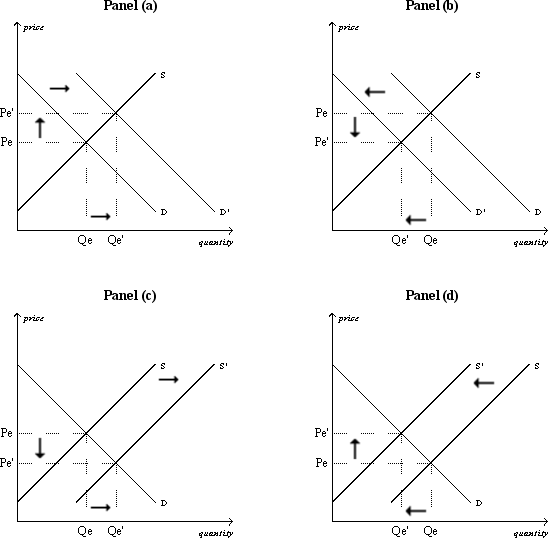 -Refer to Figure 4-22. Which of the four panels illustrates an increase in quantity demanded?
-Refer to Figure 4-22. Which of the four panels illustrates an increase in quantity demanded?
A) Panel (a)
B) Panel (b)
C) Panel (c)
D) Panel (d)
F) All of the above
Correct Answer

verified
Correct Answer
verified
Multiple Choice
Suppose that a decrease in the price of good X results in fewer units of good Y being demanded. This implies that X and Y are
A) complementary goods.
B) normal goods.
C) inferior goods.
D) substitute goods.
F) C) and D)
Correct Answer

verified
Correct Answer
verified
Multiple Choice
An increase in demand is represented by a
A) movement downward and to the right along a demand curve.
B) movement upward and to the left along a demand curve.
C) rightward shift of a demand curve.
D) leftward shift of a demand curve.
F) None of the above
Correct Answer

verified
Correct Answer
verified
Multiple Choice
A leftward shift of a supply curve is called a(n)
A) increase in supply.
B) decrease in supply.
C) decrease in quantity supplied.
D) increase in quantity supplied.
F) C) and D)
Correct Answer

verified
Correct Answer
verified
Multiple Choice
A university's football stadium is never more than half-full during football games. This indicates
A) the ticket price is above the equilibrium price.
B) the ticket price is below the equilibrium price.
C) the ticket price is at the equilibrium price.
D) nothing about the equilibrium price.
F) A) and B)
Correct Answer

verified
Correct Answer
verified
Multiple Choice
Which of the following events would cause both the equilibrium price and equilibrium quantity of number two grade potatoes to increase if number two grade potatoes are an inferior good?
A) an increase in consumer income
B) a decrease in consumer income
C) greater government restrictions on agricultural chemicals
D) fewer government restrictions on agricultural chemicals
F) B) and C)
Correct Answer

verified
Correct Answer
verified
Showing 181 - 200 of 568
Related Exams